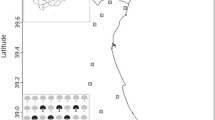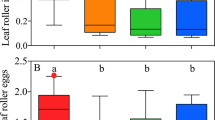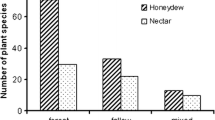Abstract
Ants can be involved in mutualistic relationships with honeydew producing hemipterans in which ants provide protection against their natural enemies, and, in return, hemipterans reward ants with honeydew. Such mutualism may affect population regulation of hemipterans by third trophic level predators. However, current knowledge regarding the effects of this food-for-protection mutualism of ants with Asian citrus psyllid, Diaphorina citri, in Florida, USA is limited. Two treatments were established in replicated small plots under field conditions in a citrus (var. Valencia) grove: (1) ants present, and (2) ants absent by exclusion with a tangle-trap sticky barrier deployed on the base of trees. Lower abundance of Coccinellidae, Araneae, and Eulophidae and corresponding higher abundance of D. citri were recorded in trees with ants compared to that recorded in trees without ants as measured by direct visual observations and stem tap sampling. In addition, ant-beetle behavioral interactions were directly investigated with three species of ants [Solenopsis invicta Buren, Dorymyrmex bureni (Trager), and Brachymyrmex obscurior Forei]. Predation of D. citri nymphs by ladybeetle larvae was reduced on leaf flushes infested with S. invicta as compared with leaves without ants and this species caused significant direct mortality to larval beetles. Our results support the hypothesis that predation of D. citri by natural enemies may be reduced in citrus groves colonized by S. invicta than in those where ant populations are suppressed. Furthermore, our results indicate that S. invicta aggressively protect D. citri nymphs on leaves from otherwise effective potential predators, such as Harmonia axyridis.




Similar content being viewed by others
References
Anjos DV, Tena A, Maura Torezan-Silingardi H, Pekas A, Janssen A (2021) Ants affect citrus pests and their natural enemies in contrasting ways. Biol Control 158:104611
Bach CE (1991) Direct and indirect interactions between ants (Pheidole megacephala), scales (Coccus viridis) and plants (Pluchea indica). Oecologia 87:233–239
Bové JM (2006) Huanglongbing: a destructive, newly-emerging, century-old disease of citrus. J Plant Pathol 88:7–37
Calabuig A, Garcia-Marí F, Pekas A (2014) Ants affect the infestation levels but not the parasitism of honeydew and non-honeydew producing pests in citrus. Bull Entomol Res 104:405–417
Calabuig A, Garcia-Marí F, Pekas A (2015) Ants in citrus: impact on the abundance, species richness, diversity and community structure of predators and parasitoids. Agric Ecosyst Environ 213:178–185
Chong J-H, Roda AL, Mannion CM (2010) Density and natural enemies of the Asian citrus psyllid, Diaphorina citri (Hemiptera: Psyllidae), in the residential landscape of Southern Florida. J Agric Urban Entomol 27:33–49
Coy MR, Stelinski LL (2015) Great variability in the infection rate of ‘Candidatus Liberibacter asiaticus’ in field populations of Diaphorina citri (Hemiptera: Liviidae) in Florida. Fla Entomol 98:356–357
Dao HT, Meats A, Beattie GAC, Spooner-Hart R (2014) Ant-coccid mutualism in citrus canopies and its effect on natural enemies of red scale, Aonidiella aurantii (Maskell) (Hemiptera: Diaspididae). Bull Entomol Res 104:137–142
Diehl-Fleig E, Diehl E (2018) Interactions among attending ants, brown-citrus aphids, and ladybugs in plants of Citrus sinensis. Neotrop Biol Conserv 13:161–170
El-Ziady S, Kennedy JS (1956) Beneficial effects of the common garden ant, Lasius niger L., on the black bean aphid, Aphis fabae. Proc R Entomol Soc Lond 31:61–65
Eubanks MD, Blackwell SA, Parrish CJ, Delamar ZD, Hull-Sanders H (2002) Intraguild predation of beneficial arthropods by red imported fire ants in cotton. Environ Entomol 31:1168–1174
Grafton-Cardwell EE, Stelinski LL, Stansly PA (2013) Biology and management of Asian citrus psyllid, vector of the huanglongbing pathogens. Annu Rev Entomol 58:413–432
Huang H, Yang P (1987) The ancient cultured citrus ant. BioScience 37:665–671
James DG, Stevens MM, O’Malley KJ, Faulder RJ (1999) Ant foraging reduces the abundance of beneficial and incidental arthropods in citrus canopies. Biol Control 14:121–126
Kaplan I, Eubanks MD (2005) Aphids alter the community-wide impact of fire ants. Ecology 86:1640–1649
Kistner EJ, Melhem N, Carpenter E, Castillo M, Hoddle MS (2016) Abiotic and biotic mortality factors affecting Asian citrus psyllid (Hemiptera: Liviidae) demographics in Southern California. Ann Entomol Soc Am 109:860–871
Liu Y, Xu C, Li Q, Zhou A (2020) Interference competition for mutualism between ant species mediates ant-mealybug associations. Insects 11:91
Michaud JP (2004) Natural mortality of Asian citrus psyllid (Homoptera: Psyllidae) in central Florida. Biol Control 29:260–269
Milosavljević I, Morgan DJW, Massie RE, Hoddle MS (2021) Density dependent mortality, climate, and Argentine ants affect population dynamics of an invasive citrus pest, Diaphorina citri, and its specialist parasitoid, Tamarixia radiata, in Southern California, USA. Biol Control 159:104627
Monzo C, Qureshi JA, Stansly PA (2014) Insecticide sprays, natural enemy assemblages and predation on Asian citrus psyllid, Diaphorina citri (Hemiptera: Psyllidae). Bull Entomol Res 104:576–585
Monzó C, Stansly PA (2020) Economic value of conservation biological control for management of the Asian citrus psyllid, vector of citrus Huanglongbing disease. Pest Manag Sci 76:1691–1698
Navarrete B, McAuslane H, Deyrup M, Pena JE (2013) Ants (Hymenoptera: Formicidae) associated with Diaphorina citri (Hemiptera: Liviidae) and their role in its biological control. Fla Entomol 96:590–597
Offenberg J (2015) Ants as tools in sustainable agriculture. J Appl Ecol 52:1197–1205
Oliver TH, Jones I, Cook JM, Leather SR (2008) Avoidance responses of an aphidophagous ladybird, Adalia bipunctata, to aphid-tending ants. Ecol Entomol 33:523–528
Pekas A (2015) Ants, pests and natural enemies in Mediterranean citrus: ecological interactions and practical implications for biological control. Dissertation, Universitat Politècnica de València, València
Piñol J, Espadaler X, Cañellas N (2012) Eight years of ant-exclusion from citrus canopies: effects on the arthropod assemblage and on fruit yield. Agric for Entomol 14:49–57
Qureshi JA, Stansly PA (2007) Integrated approaches for managing the Asian citrus psyllid Diaphorina citri (Homoptera : Psyllidae ) in Florida. Proc Fla State Hortic Soc 120:110–115
Qureshi JA, Stansly PA (2009) Exclusion techniques reveal significant biotic mortality suffered by Asian citrus psyllid Diaphorina citri (Hemiptera: Psyllidae) populations in Florida citrus. Biol Control 50:129–136
R Core Team (2020) R: a language and environment for statistical computing. R Foundation for Statistical Computing, Vienna, Austria. https://www.R-project.org/
Sanchez JA, López-Gallego E, La-Spina M (2020) The impact of ant mutualistic and antagonistic interactions on the population dynamics of sap-sucking hemipterans in pear orchards. Pest Manag Sci 76:1422–1434
Styrsky JD, Eubanks MD (2007) Ecological consequences of interactions between ants and honeydew-producing insects. Proc R Soc B Biol Sci 274:151–164
Tena A, Hoddle CD, Hoddle MS (2013) Competition between honeydew producers in an ant-hemipteran interaction may enhance biological control of an invasive pest. Bull Entomol Res 103:714–723
Vanek SJ, Potter DA (2010) Ant-exclusion to promote biological control of soft scales (Hemiptera: Coccidae) on woody landscape plants. Environ Entomol 39:1829–1837
Way MJ (1963) Mutualism between ants and honeydew producing homoptera. Annu Rev Entomol 8:307–344
Wilder SM, Barnum TR, Holway DA, Suarez AV, Eubanks MD (2013) Introduced fire ants can exclude native ants from critical mutualist-provided resources. Oecologia 172:197–205
Yoo HJS, Kizner MC, Holway DA (2013) Ecological effects of multi-species, ant-hemipteran mutualisms in citrus. Ecol Entomol 38:505–514
Zhou A, Lu Y, Zeng L, Xu Y, Liang G (2013) Solenopsis invicta (Hymenoptera: Formicidae), defend Phenacoccus solenopsis (Hemiptera: Pseudococcidae) against its natural enemies. Environ Entomol 42:247–252
Zhou A, Liang G, Lu Y, Zeng L, Xu Y (2014) Interspecific competition between the red imported fire ant, Solenopsis invicta Buren and ghost ant, Tapinoma melanocephalum Fabricius for honeydew resources produced by an invasive mealybug, Phenacoccus solenopsis Tinsiley. Arthropod Plant Interact 8:469–474
Zhou AM, Liang GW, Zeng L, Lu YY, Xu YJ (2017) Solenopsis invicta suppress native ant by excluding mutual exploitation from the invasive mealybug, Phenacoccus solenopsis. Pak J Zool 49:133–141
Acknowledgements
We thank Jude William Grosser for providing access to the field site for conducting this investigation. Finally, we thank Hunter Gossett and Wendy Meyer for their technical assistance. This work was supported by a Grant (19-002) from the Citrus Research and Development Foundation to LLS.
Author information
Authors and Affiliations
Corresponding author
Ethics declarations
Conflict of interest
The authors have no competing interests to declare that are relevant to the content of this article.
Additional information
Handling Editor: Marta Montserrat.
Rights and permissions
About this article
Cite this article
Shrestha, B., Hoyte, A. & Stelinski, L.L. Ant-psyllid mutualism affects predation of Diaphorina citri by lady beetle larvae and abundance of psyllid natural enemies. BioControl 67, 407–417 (2022). https://doi.org/10.1007/s10526-022-10145-7
Received:
Accepted:
Published:
Issue Date:
DOI: https://doi.org/10.1007/s10526-022-10145-7




